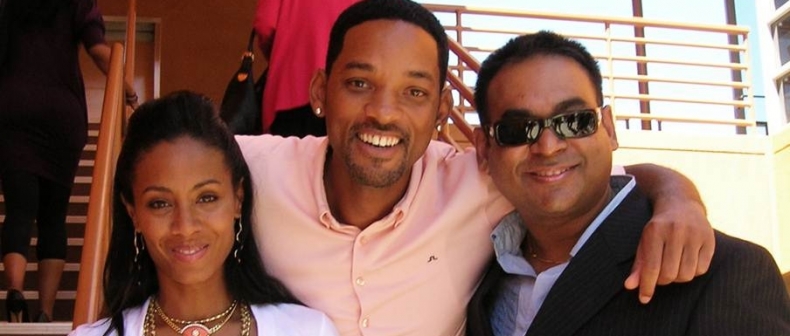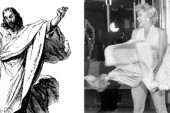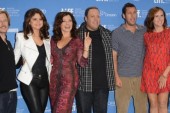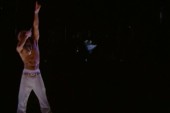
Decosta with the Smith Family
As he makes his way into the Toronto Standard offices, Jesse Decosta offers me a warm hello and smile. Decosta is an unassuming man, not what one imagines when their editor tells them that they’re going to interview one of Canada’s most succesful brand managers. Despite this nature, or perhaps exactly because of it, Decosta and his company, DeCosta Marketing Inc, count several of Hollywood’s elite stars among their client base–celebrities like Will Smith, Kevin James, and Jamie Foxx all look to Decosta for help in managing their personal brands. Decosta has been in the industry for 15 years and, as one can imagine, has a great deal of stories to share; as we sit down, Decosta tells me, among other things, about growing up in Edmonton, working with Will Smith, and producing a kid’s TV show.
What was like growing up in Edmonton, Alberta? How do you think that experience influenced you later in life?
It was the early seventies and I was young, so I don’t remember much. I do recall things being sweet, but also dangerous, especially for a brown kid in Edmonton. Now, you look at this room (Decosta points to to the workspace Extreme Startups occupies, which it shares with the Toronto Standard) and the whole world is represented in it, but Edmonton wasn’t like that in the early 70s. There was a huge negative impression of immigrants–you know, taking jobs and all that kind of stuff. So like I said, it was fun, but I used to go to school in fear (laughs). Thankfully, things started changing in the 80s.
As for how it influenced me, I think half of it has to do with my family situation at the time: my dad was unemployed for six years so we didn’t have any money. I had to find ways to entertain myself without any money. The other part of it is that Edmonton has a unique position in the country, because, for at least the last fifteen years, no one thought anything of the city. For a long time, people would say to me, “Oh you’re from Calgary?” And I would answer, “No… I’m from Edmonton.” But when you’re there growing up, you gain this perspective on Canada and rest of the world that’s very different from what anyone else in the country gets. I think that perspective, along with what I learned from my family situation, helps me with my work.
You started your professional life as a graphic designer, and then decided to make the switch to brand management and marketing later. How did you get into graphic design? And what made you decide to switch careers?
My dad was a draftsmen, and he freelanced as a graphic designer to try and make some money while he was unemployed. So I used to be with him all the time, and that’s what’s inspired me to want to move into graphic design. In 1987, after being unemployed for six years, my dad got his first job in Toronto. He moved to the city ahead of us to help set us up, but then he passed away three months after coming to the city from a heart attack.
So when we moved to Toronto we had to figure stuff out. One of the first things I did to earn money was draw caricatures. Following that it was natural to move into graphic design.
That said, I think I was an okay designer, but I didn’t think I was going to be the best designer. So I thought that I had to find what I was best at. I learned that I had a stronger skill set of understanding the bigger picture of marketing and branding than I did graphic design.
How did you meet singer Deborah Cox (the contact that would help Decosta make his initial foray into the world of celebrity branding)?
It was a meeting that was set up by mutual contacts–specifically our lawyers. I can’t remember exactly how the meeting came about… this was in 1998.
Okay, but that obviously lead to meeting Will Smith. What was that like?
Weird at first. I was and still am a Will Smith fan. He’s a great guy. There was a change in management that brought us together. We started working with Overbrook Entertainment, Smith’s entertainment company.
What it’s like to work with Will Smith?
I’ll say this: first of all, he and his family are genuine, friendly, good natured people. They really care about the people that are around them and the people that they choose to work with them. If you’re working with them, you’re treated like family. There’s a mutual respect and loyalty.
In my opinion, one of the most interesting clients you help manage is the estate of Tupac Shakur. What is like to manage this brand that is not only well-established, but one that so many people are invested in? I imagine there’s a kind of weight to managing a brand like that?
It’s been a revelation. Most of the other brands we work with it’s a fan/artist relationship. With the Tupac brand, however, it’s almost like a religion: It’s a movement that’s in the air and that you can’t touch. There’s an undying love a lot of people have to something greater than even Tupac; it’s about the things that he believed in and stood for while he was alive.
The challenge with the Tupuc brand is that we have to be very careful with what we do with it. Sometimes we think we’re doing something that is in the best interest of what Tupac stood for, but it can easily be perceived in the wrong way. We get it now; when you have eight million people telling you they don’t like something, you quickly learn what’s acceptable to fans. Now, we’re searching for things that fulfil their needs and bring everyone together.
Out of curiosity, were you involved with the hologram of Tupac that “preformed” at Coachella?
We were pitched on the idea by Dr Pepper. We didn’t produce the hologram, but our management team selected the images that helped create it.
What was your reaction to the pitch?
I thought it was pretty cool. A lot of Tupac’s most devoted fans now were either not born yet or too young to go see him preform while he was alive, so for them to be able to see something like must have been pretty cool.
I would think a brand like Will Smith’s or Tupac’s is established and well-respected, so there’s not much work to be done there, but I imagine you’re going to tell me there’s still a lot of work that has to be done to maintain that brand.
Well, in terms of Will, he’s very careful about what he says–like I said before, he’s a very thoughtful person to begin with–so he’s an easy client to work with that way. But in terms of his brand, the future is something that’s very important to him, especially his kids’ future. They’re growing up and have really exciting projects coming up that we’re working on.
In researching for this interview, I read an article in the Globe and Mail, and something that was stressed in that article is that you understood the potential the Internet represented when you entered the business. What did you see about the Internet at that stage that made you realize artists weren’t taking full advantage of it?
I think the unique standpoint I had was that when I got out of college was that I was already working with computers. When the Internet started to gain popularity in 1992 and 1993, I was constantly asking myself: “Why does this band not have a webpage?” There was obviously no Facebook or Twitter at that time, but in general, you couldn’t even find basic information on a band if you wanted to.
Moreover, there was no easy way to get pictures from a website–it was a complicated process back then: you had to get slide transparencies, scan them, and then finally put them up on a website. So it didn’t make sense to my why more musicians didn’t have pictures of themselves online. At the time, record labels were very corporate–in the sense that they didn’t have anyone in house that worked on this kind of stuff and, if they did, they were interns, who were likely really smart but never got a chance because they lacked the lacked the funding or resources to carry out a project like digitizing pictures. So there was a gap there that I wanted to fill.
Helping brands successfully migrate to the Internet was something that set you apart from your peers in the past, but what factor(s) help separate yourself from your peers in the present?
I think it’s important to never stop thinking of new ideas; not necessarily something that’s bleeding edge, but maybe a combination of things that makes sense to the client and excites them. We spend a lot of time getting to know our new clients. For instance, if I were to take you on as a client now, I would go out and search for things that would fulfill your needs. Working with me, I want you to say, “Wow. this is not about money anymore. This is about doing something that is fulfilling my needs.” I think that’s what sets us apart from our competitors.
Beyond managing celebrity brands, I’ve noticed you work with a lot of corporate clients–for instance looking at your site, I saw that you’ve worked with McDonalds. How do you approach working with a corporate client as opposed to a celebrity one?
We helped McDonalds with their first website, which was launched in 2000, and they kept the same design for 11 years. We did a website that looked like the drive-thru and looked like the restaurant. After four years, I was like, “Come on, guys, you gotta change the site.” We stepped out because they took everything in internally. I list them as a past client because I helped them build something that stayed up for more then a decade. Although as the Internet got more advanced, the site started to shrink onscreen as it was designed for an 800×600 pixel screen.
We have a great relationship with the Ontario Municipal Insurance Exchange, which handles all the insurance of the all the municipalities in Ontario . We love working with them. They take something that’s so dry and make it fun and fun to work on.
How do you approach working with a client like that as opposed to someone like a celebrity? Or do you bring the same approach, which is to bring something creative to the table?
That is what it is. I don’t feel like it’s any different, and when I talk to one of my corporate clients, I talk to them about in the same way that I talk to my celebrity clients.
You told us a bit about Jesse the brand manager, but what about Jesse the person–what are some things outside of work that inspire and motivate you?
Anything Star Wars…
Okay, so what is your opinion about the recent purchase of the brand by Disney?
Can I be candid?
Of course.
I think it’s a good thing. I think George Lucas ran out of steam. I think Disney will bring a fresh approach to it. The brand needs to be rebooted–like Batman or Star Trek.
I love to cook, too.
Have you contacted Disney and told them, “I’d like to help you manage this brand?”
No, I’m afraid to. If it’s something that is near and dear to me, I don’t want to work with it. I find that when I start working with a brand or artist I discover who they really are, which isn’t necessarily a bad thing, but it takes some of the magic away. So there’s some brands that I don’t want to work with because I have this childhood memory of it that I want to hold on to.
Any memorable stories from your career that you can share?
One of the most interesting meetings I’ve ever had was with Monica Lewinsky, and it was right around that time. So a business partner of mine in New York tells me, “Oh, I need you to meet with new client of mine, and help her with her brand.” I asked him who she was, and he just said, “I’ll set up the meeting. We go down to Soho and go into this tiny, little restaurant, and we waited. He says, “You’ll see.” The door opens. Everybody stood up and started taking pictures. For me, it wasn’t about the “celebrity,” because she wasn’t a celebrity, but she was someone in the news. It was bizarre to have been on the airplane to reading about this thing , it was maybe 4 weeks after the news broke out, and there she was. We had dinner, we had this conversation. I asked her what she was looking from me, and said, “What do you think?”
Did you end up helping her in any respect?
We talked about it, but I discovered that we couldn’t help her with what she needed. She wanted to create products and get them to market, and that’s not what we do. Still, it’s something that’s still fresh in my mind.
You spend a lot of your time working in Los Angeles, yet still live in Toronto/Mississauga. What is it about this city that keeps you here?
The one thing that I find about Canada is that there is a fabric within people. I find more real people here than anywhere else. I go to other places. But here, I meet someone and they’re just a normal person; there isn’t a hidden agenda. I think LA is great to visit, but that’s a high octane lifestyle that the city lives. If I lived there, I would probably be out every night and I wouldn’t see my kids.
And with that, I think we’re running out of time, so is there a project or two that you’re excited about and want to share?
On the business side, I would like to get into content creation. I just became an executive producer on kids TV show that is being produced by PBS “Hey Kids Lets Cook!” It puts all my joys together–cooking, kids, television and stuff–and I’m having a lot of fun with that. It’s a new thing for me, and a new thing for the company, but I can see us getting more involved in things like that.
I imagine you’re glad Obama won?
Yeah, you have no idea. I was worried the show might get cut if Romney had won.
____
Igor Bonifacic is a writer working for the Toronto Standard. You can follow him on twitter @igorbonifacic.
For more, follow us on Twitter @TorontoStandard and subscribe to our newsletter.














